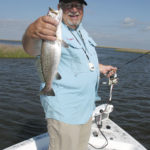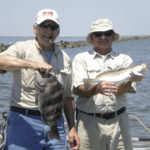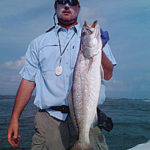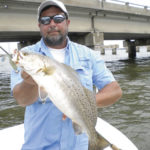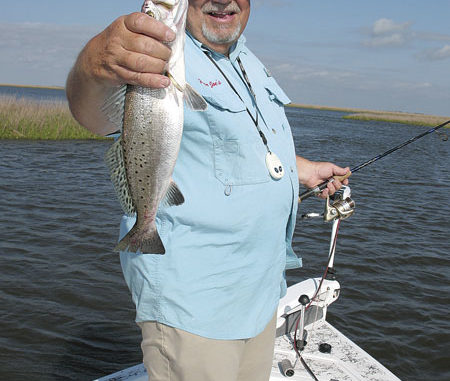
Spillway opening pushes fish to unusual places
Unless you are strictly a freshwater angler, the opening of the Bonnet Carre’ Spillway has definitely altered your fishing plans for the summer. On May 9, the Corps of Engineers began opening the bays of the spillway to divert some of the rising river water into Lake Pontchartrain, and from there into the Gulf. Eventually they would open 330 of the projects 350 bays, sending enough fresh water into the lake to make it a virtual extension of the Mississippi River.
The opening was a painful but necessary step
to reduce the height of the swollen river at New Orleans and prevent it from overtopping the levees or breeching them altogether. Thankfully, the
project worked like it was designed to, and with
the additional opening of the Morganza Spillway above Baton Rouge, the possibility of a major
flood event at either metropolis was averted.
Fishing, however, was adversely affected, and will be for quite some time. How far will the fresh, muddy river water reach? Will Lake Pontchartrain be fishable at all this summer? This fall? What about Lake Borgne? What about the east and west sides of the river and other areas?
For answers to these and other questions, Louisiana Sportsman interviewed coastal scientist and acting executive director of the Lake Pontchartrain Basin Foundation, John Lopez (www.saveourlake.org).
Lopez says they have closely monitored the transition of the lake from its usual br ackish water into basically an arm of the Mississippi River.
“The salinity levels fell quickly once the sheer volume of the water pouring through the spillway gates diluted and displaced the normal lake water, until the level today is virtually nil,” he said. “The fresh, muddy river water has displaced the normally brackish lake water nearly 100 percent.
“There could be a pocket here or there with some slight salinity left. The northwest corner had a small section for a while, but the sheer volume of fresh water flowing into the lake will reduce that to the point that Lake Pontchartrain will be near 100-percent fresh.”
Fish kills
Lopez says some fish kills have already been reported, but they were small in number and unusual.
“Normally you see a lot of small fish affected in a fish kill, usually by the depletion of oxygen in the water,” he said. “The ones we saw so far were larger fish, and not many of them, so we suspect some other cause of death. But fish kills can be expected over the summer in Lake Pontchartrain as the turbidity decreases, the nutrients brought into the lake settle and the heat turns on, resulting in toxic algae blooms. Those depleted oxygen zones become dead zones, and fish kills are possible.
“However, the recreational fish like trout and redfish will not be affected because they’re already gone from the lake, pushed out by the fresh water. What will be affected is the freshwater fish that flushed in through the Spillway — mostly carp and catfish.”
Lopez said the algae blooms showed up in the lake by July 12 when they last opened the spillway in 2008.
“But they opened the spillway a month earlier that year,” he said. “I suspect the blooms will show up about the same time this year due to the heat, and I also think they’ll persist longer this time because it’ll take longer to circulate those nutrients out of the lake, due to the closure of the Intracoastal Canal at Seabrook and the MRGO, leaving only the Rigolets and Chef as conduits in and out.”
Lopez said we can expect it to take 6 to 8 months or even longer to get the lake back to normal salinity levels.
“The lake will heal itself over time. Nature is resilient, but this amount of fresh water brought in a load of nutrients that will take time to flush out,” he said.
Lake Borgne impact
Surprisingly, Lopez doesn’t think Lake Borgne will suffer the same fate as Lake Pontchartrain.
“Despite the closure of the MRGO at Hopedale, which normally would have allowed water to flow much more freely in and out of Lake Borgne from the south side, it still has wide egress through the Mississippi Sound on the north side,” he said. “I think Lake Borgne will basically become what Lake Pontchartrain was; that is, fresh on the west end like Lake Maurepas, but brackish on the east side.
“I think the salinity levels will be essentially what those of Lake Pontchartrain usually are, and though they may be diluted somewhat, there could be enough circulation to keep the lake productive and fishable. The possibility is that Lake Borgne could get all the trout and redfish action that Lake Pontchartrian usually has at this time of year, so it could be very productive.”
Echoing that sentiment, Frank Campo Jr., over at Campo’s Marina in Shell Beach (504-239-5165), said previous openings of the spillway didn’t really hurt them.
“It could be different this time because the fresh water can’t really escape as fast as it used to down the MRGO,” he said. “Worst-case scenario, we could be inundated by muddy river water and socked in for weeks.
“It would ruin Lake Borgne temporarily and make it impossible for us to keep bait alive.
“What we hope is that any fresh water that flows our way will circulate right back out through Bayou LaLoutre on either side and through Mississippi Sound.
“Some years ago when they opened the Spillway, the trout stacked up so thick on the east side of Lake Borgne that you’d kill fish with your prop when you passed by.
“The key will be to see what the wind and current do with all that fresh water coming through the passes. I think it’ll depend on whether we get good water coming in through the sound from the Gulf, and that’ll depend on winds and tides.”
Bayou Bienvenue impact
Lopez says Bayou Bienvenue is a question mark.
“Seabrook is dammed off, so the river water won’t be pouring into the area from there,” he said. “It would have to come in either through the ICW or Lake Borgne, and the ICW is at least partially obstructed by the big Wall. However, the gate in the ICW will remain open so a good tide will still flow through.
“I do expect the salinity to fall in the Bayou Bienvenue region, but it will probably be more like Lake Borgne’s levels than Lake Pontchartrain’s, so the fishing could possibly remain very good there.”
But Jimmy Dixon Jr. over at Bait, Inc. (504-277-3755) says the fresh water has already shown up down their way much sooner than expected.
“We’ve found muddy river water at the Wall, so we know it’s around us,” he said. “We’ll have to wait and see if the winds and tides flush it out or flush it in. I have more questions than answers right now.
“If we are surrounded by fresh water, I can still make salt water and keep bait alive in my tanks. But that’s not the issue. How far will I have to run to catch bait, at $4 per gallon, and even if I have it, who will buy it? Nobody will be fishing anywhere around this area if it’s all fresh water.”
Impact/factors in other areas
A high river always means anglers will have to search for clean water on the west side of the river, from Myrtle Grove, Port Sulphur, Buras, Empire and Venice. Some of them and Lafitte-area anglers will likely make the run to the Barataria Basin, which might also be fresher than normal but still fishable.
On the east side, fresh water will pour through Ostrica and the numerous openings into Breton Sound and its fringe bays. But Lopez says there is enough circulation in the area so south and east winds and tidal currents will keep salinity levels up.
“There will be places that are basically river water, but anglers should have no trouble locating decent, fishable water,” he said. “The corps is not opening the diversions to capacity so that won’t be a major factor either.”
Spillway effect options
I made a recent run into Hackberry Bay out of Lafitte with Capt. Papa Joe Bush (504-689-3728). This is the time of year that the trout and redfish action along the beaches and islands down south really turns on, and I wanted to jump on some of that excitement.
We did find muddy water, but it wasn’t from the river; it was due to those persistent, bellowing winds. We fished several of the islands and beaches, and did manage to find some nice-sized trout in spite of the winds.
The birds must have taken a vacation day because none were working over schools of shrimp. The only gulls we saw were the lazy sluggards following the shrimp boats looking for an easy meal.
The trout we found weren’t stacked up either, but were scattered here and there, so we had to peck away at them, catching one here and one there until we had some fish.
Bush says Barataria Bay and the beaches from Bayou Lamier to Grand Isle will not be affected by the high river, and trout action will be excellent in the early mornings.
“Live bait is good but not necessary, and glow/chartreuse plastics fished about 18 inches under a cork or tightlined will work just fine,” he said. “Reds will be schooling at the top end of Barataria Bay as well as Hackberry Bay.”
Grand Isle Capt. Mark Scardino (985-787-3529) agrees with Bush that the waters in his area are unaffected by the high river or the spillway openings, and the specks are thick, fat, and ready to be plucked.
“The trout are stacked up at the rocks, the reefs, the beaches, the tank batteries, the passes — and they are hungry,” he said.
Scardino says the biggest problem they face in Grand Isle right now has nothing to do with dirty water from the spillway or high river, but from the wind.
Venice/Empire/Buras
The high river does have an effect in the region, but it doesn’t make the area unfishable.
Venice Capt. Brent Roy (225-268-8420) says the speckled trout and redfish action hasn’t let off at all.
“If anything, we’re having a better-than-usual season, catching bigger trout and more of them than we have in the last 10 years,” he said.
Roy attributes the bonanza to the previous closures of the fishing seasons allowing stocks to rebound.
“There’s been virtually no pressure on the fish for almost two years, so we’re finding more fish than usual,” he said.
He says the challenge is to find clean water, and to do that you have to be willing to look and travel.
“The fish aren’t going anywhere; they’re just moving with the currents to stay ahead of the dirty water,” he said. “They might be on the east side today and the west side tomorrow and downriver the next day. But they’re out there, in the pockets of clean water and in places where the surface looks dirty but green water is underneath. Check your prop wash.”
Shell Beach/Hopedale/Delacroix/Pointe a la Hache
Capt. Jack Payne, over at the Sweetwater Marina (504-453-8382), says the jury is still out on just how adversely the Delacroix Island/Pointe a la Hache area will be affected by the high river and spillway opening.
“The good news is the river is now falling, but the bad news is it’s already put a whole lot of fresh water into the Black Bay area,” he said. “Winds and tides will have to dictate where to fish.
“Some of the rigs and usual summer hotspots may have dirty water around them, but you can check your prop wash to see if cleaner water is underneath, or you can search around for cleaner water. There will be some good fishable water out there, but it’ll be up to you to find it.”
Payne says there are still plenty of decent fish on the inside in lakes off the Twin Pipelines at cuts, points, drains and under the birds.
“If the river falls or good south and southeast winds push clean water in, fishing should be good in all the usual summer spots — Iron Banks, Stone Island, Lonesome, Mozambique Point, the Wreck and all the various wells and rigs in Black Bay, and all the way out to Breton Island,” he said. “I hope we won’t have to run that far to find fish, but we will if we have to.”
But Glen Sanchez, over at the Breton Sound Marina (504-676-1252), thinks the Hopedale area might be the surprise beneficiary of the high river water.
“We’re sandwiched in between. The muddy water will push in from Lake Borgne on one side and from Black Bay on the other, and we should be sitting pretty in the exact spot all the fish and bait will run to,” he said. “I expect a speckled trout bonanza this month.”
